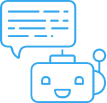What comes to mind when you hear the word annotation?


Annotation refers to the labeling of any kind of data. When you add labels to your smart phone contacts, you’re annotating data. Labeling makes it easier to retrieve your “favorites” or ignore calls from less-than-favorites.
Annotation differs by data and content type. Here are other examples:
- Written/transcribed text annotation: Labeling written representation of linguistic or non-linguistic units.
- Image annotation: Categorizing images or labeling objects within.
-
Audio annotation: Categorizing/transcribing audio or labeling events within.
Supervised Learning: The key to quality annotated data.
Rather than discussing the advantages of annotated data, let’s focus on the method used to employ the data—supervised learning.
There are many strong points of supervised learning, compared to unsupervised learning:
- Visibility on the data and how the system works
- Easy analysis of results or troubleshooting
- Re-use of data to automatically annotate more data (bootstrapping)
- Control over the data
Annotated data enables supervised learning, which happens in a controlled way. And for a better learning model, the quality of annotation is crucial!
Let’s discuss what written/transcribed text annotation means.
Any spoken corpus can be converted to a written corpus and worked on. Annotation tasks on a written corpus include:
Morpho-syntactic annotation: The purpose of this kind of annotation is to answer the following questions and many more:
- Is the verb in the past or present tense?
- What is the subject/verb of the sentence?
- Is the adjective modifying the first noun or the second noun?
Example for morphological analysis and part of speech tagging:
Example for syntactic annotation (dependency grammar):
Semantic annotation: The purpose of the semantic annotation is to discover about the meaning relations of the words to find out about multiple phenomena. For example:
- To find out about the named entities in the text: products, locations or zip codes, people names, tracking IDs, etc.
Example: “Boston” is ambiguous because it can be a city name or a person’s name. With annotated data, named entities can be disambiguated.
Boston[person] is my favorite friend.
Boston[location] is my favorite city.
To carry out co-reference resolution.
Example: When a pronoun is used, it can refer back to many nouns in the context. To disambiguate them, semantically annotated data is used to resolve the ambiguity.
Jack asked Jamie to help him[Jack).
Jack asked Jamie if he[Jamie] knew what happened.
Topic classification: The purpose is to classify given texts with given topics. Any keywords inside texts can be annotated, as well. This way, with or without any words labeled, texts can be automatically categorized to understand if they’re about Sports or Technology.
|
Sentence |
Topic |
|
Net income for the first three months of 2010 dropped to $1.9 billion. |
Business |
|
The largest Arctic ozone hole ever measured is concerning millions. |
Science |
|
The game was won with a late goal from the youngest player in the team. |
Sports |
|
Newly developed devices help you check in on your elderly easier! |
Technology |
What is image annotation? And why would one annotate an image?
Images contain a lot of content in them. One can annotate the images themselves by categorizing them, for example, or can annotate the objects in it.
For humans, it is mostly easy to recognize the object boundaries in images (or in real life); however, the same may not always apply to machines. There are many instinctive cues for us to be able to differentiate an object from another one or from the background. With high-quality, labeled data, machines can learn object boundaries, as well!
A more complicated next phase of image annotation is video annotation, where objects in motion and actions are annotated such as a person “extending their arm” and “turning the lights off”.

Interested to know about audio annotation? Let’s discuss it briefly!
Audios are often used to improve the quality of speech-related systems. They can be transcribed with or without annotation and in either case, it is an asset for machine learning.
Annotation in audio files can contain labeling extra-linguistic items such as human or non-human noises: e.g., coughing, breathing, or whistling as human noises and engine revving and wind howling as non-human noises.
In addition, all events can be timestamped in audios, which will, in turn, help a correct prediction in categorizing the events. Where a music segment stops and a human speech starts may be simple information for humans, but can be challenging for machines without annotated data.

If you would like to learn more about our data annotation services please visit our dedicated DataForce website HERE.

 Data Collection
Data Collection  Data Annotation
Data Annotation  Data Moderation
Data Moderation Transcription
Transcription  Chatbot Localization
Chatbot Localization  Generative AI Training
Generative AI Training User Studies
User Studies  Data Relevance and Rating
Data Relevance and Rating  Automotive
Automotive Cybersecurity
Cybersecurity  Finance
Finance  Life Sciences
Life Sciences  Manufacturing
Manufacturing  Retail
Retail  Technology
Technology  Travel
Travel  Filter by Service
Filter by Service Filter by Technology
Filter by Technology Filter by Industry
Filter by Industry DataForce Live
DataForce Live  Educational Video Hub
Educational Video Hub  Blog Posts
Blog Posts  DataForce Presentations
DataForce Presentations Additional Resources
Additional Resources News
News